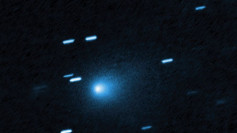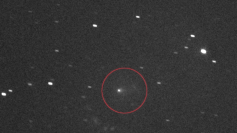The interstellar object known as 3I/ATLAS continues to draw scientific interest and online speculation, particularly after social media claims that the China National Space Administration released high-resolution video showing the object as "gigantic" and lacking a cometary tail. The footage has not been verified, and astronomers caution that no official imagery from China or the United States confirms the circulating clips. Nonetheless, the unusual behavior of 3I/ATLAS has renewed comparisons to the 2017 interstellar visitor 'Oumuamua and prompted renewed inquiry into what distinguishes the object from typical comets.
3I/ATLAS was first detected on July 1 by the Asteroid Terrestrial-impact Last Alert System (ATLAS) telescope in Chile. NASA has confirmed that it is traveling on a hyperbolic trajectory, meaning it is not gravitationally bound to the Sun. The object's solid nucleus is estimated to fall between roughly 0.32 kilometers and 5.6 kilometers in diameter, with Hubble imaging establishing the upper size limits. It is moving at approximately 60 kilometers per second, or about 137,000 miles per hour.
The source of current speculation is the object's unusually weak or intermittently absent tail. Under standard comet behavior models, heating from solar proximity causes sublimation of volatile ices, producing gas and dust that form a visible tail. During its closest approach to the Sun at roughly 1.4 astronomical units, 3I/ATLAS exhibited a faint coma and-with certain observations-no clearly detectable tail. This differs from most comets entering the inner Solar System.
Scientific commentary has highlighted several additional anomalies. Observers have noted that the object brightened more rapidly than many comets at similar distances. Some analyses indicate possible non-gravitational acceleration, suggesting that mass loss or outgassing may be driving motion not accounted for by gravity alone. Astronomers have also recorded instances where dust appears to trail toward the Sun, a known optical effect known as an anti-tail, caused by viewing geometry rather than physical reversal.
Public interpretations have diverged sharply. Publications such as Scientific American have described 3I/ATLAS as an unusual comet rather than an artificial object, noting that interstellar ice and dust composition may differ significantly from that observed in Solar System comets. Some independent researchers have emphasized that the lack of a prominent tail does not contradict natural models, particularly if the object is low in volatile ice or oriented in a trajectory where dust is not easily illuminated from Earth.
The viral claims regarding China's involvement emerged after online posts alleged that the China National Space Administration released previously unseen imagery. Reporting from the International Business Times UK referenced the claim but found no corroborating data. To date, neither NASA nor CNSA has published new imagery tied to the period when the object passed Mars. Space agencies typically subject such data to processing review before public release, a timeline that can extend for months.
Scientists expect new observations in December, when 3I/ATLAS emerges from the Sun's glare, allowing renewed ground-based and orbital telescope imaging. Continued monitoring by the Hubble Space Telescope and other observatories is underway. Researchers emphasize that interstellar objects represent rare opportunities to examine material formed around distant stars and may help refine models of planetary and cometary system formation throughout the galaxy.





